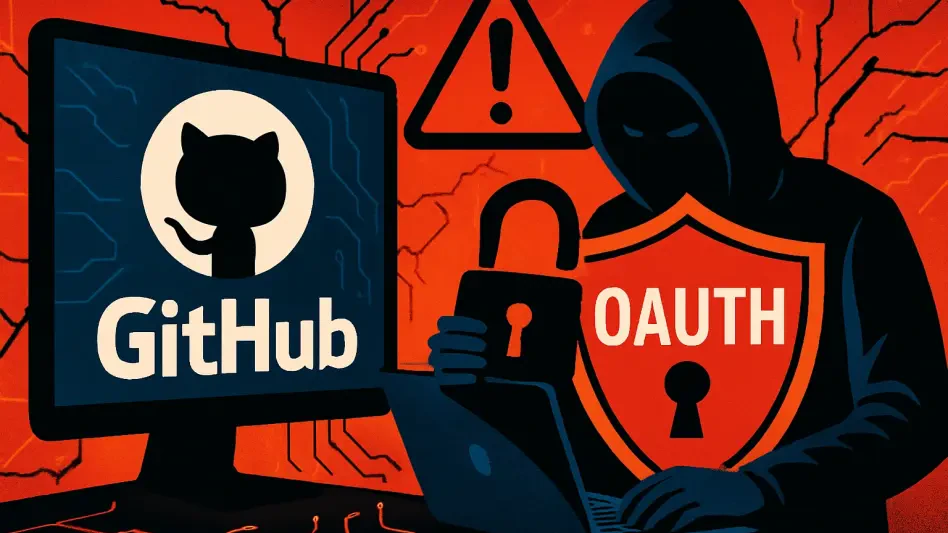Imagine a scenario where a single compromised account on a widely used platform like GitHub cascades into a breach affecting multiple organizations, exposing sensitive business data across interconnected systems. This isn’t a hypothetical situation but a stark reality that unfolded recently with the Drift application, a product of Salesloft, revealing the fragility of third-party integrations. The incident, centered on stolen OAuth tokens, has sent shockwaves through the cybersecurity community, prompting a deeper examination of how such technologies operate and where vulnerabilities lie. This review delves into the mechanisms of GitHub OAuth token security, the exploitation that occurred, and the broader implications for integrated software ecosystems.
Understanding GitHub OAuth Tokens and Third-Party Integrations
At the heart of modern software collaboration lies GitHub, a platform where OAuth tokens serve as digital keys, granting access to repositories and integrated applications without exposing user credentials. These tokens are essential for seamless interactions between platforms like Drift, a Salesloft product for customer engagement, and other systems such as Salesforce, which many businesses rely on for customer relationship management. The elegance of this system lies in its ability to streamline workflows, but it also introduces a critical dependency on the security of these tokens and the trust placed in third-party integrations.
The incident under scrutiny began with unauthorized access to a Salesloft GitHub account, where an attacker exploited private repositories to download content, add unauthorized users, and manipulate workflows. This breach wasn’t merely a standalone event but a gateway to further intrusions, highlighting how OAuth tokens, when compromised, can unlock access far beyond their intended scope. The interconnected nature of these technologies means that a flaw in one part of the chain can ripple across multiple environments, affecting countless end users.
What makes this particularly alarming is the scale of potential exposure. When tokens tied to applications like Drift are stolen, they can provide attackers with entry points into sensitive data stored in integrated platforms, including business contact details. This review aims to dissect the performance of OAuth token security in light of such risks, evaluating how well—or poorly—current mechanisms protect against sophisticated threats.
Performance Analysis: Where OAuth Security Faltered
Drilling deeper into the breach, the initial compromise of the GitHub account served as a launchpad for the attacker to probe both Salesloft and Drift environments. While the core Salesloft platform saw limited impact, confined to reconnaissance, the attacker successfully escalated access into Drift’s AWS infrastructure. Here, the theft of OAuth tokens became the pivotal moment, enabling unauthorized access to customer data through Salesforce integrations, a widely used enterprise tool.
The performance of OAuth token security in this instance reveals significant gaps, particularly in token management and monitoring. Once stolen, these tokens acted as unchecked passes, allowing the attacker to infiltrate systems without immediate detection. This incident underscores a critical flaw: the lack of robust mechanisms to invalidate or limit the scope of compromised tokens swiftly, leaving integrated applications vulnerable for extended periods.
Moreover, the breach exposed a broader trend of coordinated campaigns targeting Salesforce integrations across multiple companies. Organizations such as Zscaler, Palo Alto Networks, PagerDuty, and Cloudflare reported unauthorized access to their data, with exposed information including names, email addresses, and job titles. The scale of this impact illustrates that the failure of OAuth security isn’t just a technical misstep but a systemic issue in how third-party integrations are safeguarded against evolving threats.
Response and Mitigation: Evaluating Recovery Efforts
In the wake of the breach, Salesloft’s response provides insight into the challenges of securing OAuth-based systems. Engaging Mandiant, a leading cybersecurity firm, on August 28, the company initiated a thorough investigation that traced the root cause to the GitHub compromise. The findings confirmed that while Drift’s environment was heavily impacted, Salesloft’s core infrastructure remained relatively insulated due to effective segmentation, a design choice that proved crucial in limiting damage.
Mitigation efforts focused on immediate containment, including rotating credentials across affected systems, isolating Drift’s infrastructure, and enhancing security protocols to prevent recurrence. Proactive threat hunting across the company’s environments revealed no further compromise, and Mandiant’s validation of the technical separation between Drift and Salesloft platforms highlighted a silver lining in an otherwise troubling incident. These steps demonstrate a reactive strength in OAuth security recovery, though they also raise questions about why such vulnerabilities existed in the first place.
A critical takeaway from this response is the need for preemptive measures in token management. While containment was effective after the fact, the incident suggests that real-time monitoring and automated token revocation could significantly reduce the window of opportunity for attackers. This aspect of OAuth security performance remains an area ripe for improvement, as reactive strategies alone cannot fully address the speed and sophistication of modern cyber threats.
Industry Implications: A Wake-Up Call for Integration Security
The broader implications of this breach extend far beyond a single company or platform, pointing to a coordinated campaign targeting Salesforce integrations across the industry. Cybersecurity experts from Google’s Threat Intelligence Group and Mandiant have linked these attacks to the threat actor group UNC6395, indicating a level of organization and intent that challenges existing security paradigms. This trend emphasizes that OAuth token vulnerabilities are not isolated flaws but part of a larger strategy to exploit interconnected systems.
For organizations relying on third-party integrations, this incident serves as a stark reminder of the shared responsibility in securing digital ecosystems. The exposure of sensitive data across multiple entities underscores the cascading effects of a single point of failure, pushing the industry toward reevaluating trust models in software integrations. The performance of OAuth security, in this context, is not just about technical capability but also about fostering collaboration among vendors to address systemic risks.
Another dimension to consider is the evolving nature of threat actors, who adapt quickly to exploit gaps in token-based authentication. The unverified claim of responsibility by a group dubbed “Scattered Lapsus$ Hunters” adds a layer of complexity, suggesting that hybrid tactics from multiple known entities may be at play. This dynamic environment demands that OAuth security evolves from static protections to adaptive, intelligence-driven defenses capable of anticipating such coordinated efforts.
Final Thoughts on OAuth Token Security
Looking back at the Drift breach and the exploitation of GitHub OAuth tokens, it became evident that while the technology offers immense convenience for integrating platforms, its security mechanisms struggled under the pressure of a determined attacker. The incident exposed critical weaknesses in token management and the broader architecture of third-party integrations, impacting numerous organizations with far-reaching consequences. Salesloft’s response, though commendable in its speed and thoroughness, arrived after significant damage had already occurred.
Moving forward, the industry must prioritize actionable improvements in OAuth security, starting with stricter token lifecycle management and real-time anomaly detection to curb unauthorized access. Enhanced segmentation practices, as demonstrated by Salesloft’s limited core impact, should become a standard for mitigating risks in interconnected systems. Additionally, fostering greater collaboration among technology providers to share threat intelligence could preempt future campaigns targeting integrations like Salesforce.
Beyond technical fixes, there’s a pressing need for organizations to reassess their dependency on third-party applications, balancing convenience with robust risk assessments. As cyber threats continue to evolve, investing in proactive security frameworks over the next few years, from this year to 2027, will be crucial to safeguard sensitive data. This breach served as a pivotal lesson, urging a collective push toward resilient, adaptive defenses in an increasingly interconnected digital landscape.








